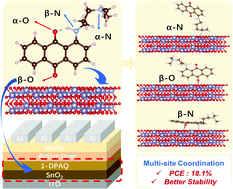Efficient interface modification via multi-site coordination for improved efficiency and stability in organic solar cells†
Abstract
Low work-function metal oxides have been widely used as electron transport layers (ETLs) in organic solar cells (OSCs). However, the ubiquitous contact barrier and intrinsic surface defects of such ETLs severely restrained the efficiency and stability of OSCs. Here, a strategy for multi-site coordination was adopted by designing and introducing an anthraquinone derivative (1-DPAQ) to passivate the surface defects of SnO2 ETLs. We find that the modification of 1-DPAQ can optimize the work function and improve the conductivity of the SnO2 layer. Besides, systematic theoretical analysis and characterization studies have revealed that stable coordination interactions exist between SnO2 and 1-DPAQ, filling the oxygen vacancy of SnO2. 1-DPAQ effectively inhibits the charge recombination and improves the charge collection ability simultaneously. In addition to achieving high PCEs of 17.7% and 18.1% for the binary and ternary active layer, the OSC devices based on the SnO2/1-DPAQ composite ETL exhibit significantly improved device stability. This work highlights the working mechanism of multi-site coordination on interface modification and represents a feasible and straightforward method to optimize the properties of metal oxide ETLs for efficient and stable OSCs.



 Please wait while we load your content...
Please wait while we load your content...